Think you don’t have room for houseplants? Think again! Even the tiniest spaces can come to life with the right greenery. Whether you live in a small apartment, dorm room, or just want to add a touch of nature to your desk or shelves, these compact houseplants are proof that size doesn’t matter when it comes to making a big impact! Learning about Hoya care and how to care for Hoya will help you understand the needs of your plant.
When it comes to Hoya plant care, it’s essential to know that Hoyas are easy to care for and can thrive in small spaces with proper care. They require bright, indirect light and should be watered sparingly, making them perfect for busy people who want to bring some life to their space. Understanding how to care for Hoya is crucial for the plant’s survival and will help you enjoy the benefits of having a beautiful, trailing vine in your home.
By following the right Hoya care guidelines, you can keep your plant happy and healthy. This includes providing the right amount of light, water, and nutrients. With proper Hoya plant care, you can enjoy the beauty of your plant and the benefits it brings to your space. Learning about Hoya care will help you become a better plant parent and keep your Hoya thriving.
Key Takeaways
- Hoyas are easy to care for and can thrive in small spaces with proper care.
- They require bright, indirect light and should be watered sparingly.
- Understanding how to care for Hoya is crucial for the plant’s survival.
- Hoya care includes providing the right amount of light, water, and nutrients.
- Proper Hoya plant care can help keep your plant happy and healthy.
- Hoyas can tolerate low light levels, making them suitable for apartments and office settings.
Introduction to Hoya Plants
Hoya plants are special and have unique traits. They come in over 200 species, each with its own look. To care for your Hoya, knowing their needs is key. Follow Hoya plant care tips and Best practices for Hoya care.
Hoyas can grow well in many places. They’re perfect for indoor gardens. A good Hoya care guide helps them get the right light, water, and food.
What Makes Hoyas Unique?
Hoyas have beautiful, waxy leaves and grow as vines. They can climb up or trail down. With the right care, they can live up to 30 years indoors.
Popular Types of Hoya Plants
Popular Hoyas include Hoya carnosa, Hoya ‘Endless Cascade Shining Sea Star’, and Hoya Quinquenervia. Each has its own special features, like fragrant flowers or bright leaves. Exploring different Hoyas helps you find the perfect one for you.
Understanding Hoya Needs
To keep your Hoya plant happy, you need to know its basic needs. You must give it the right light, water, and humidity. By doing this, your plant will grow well and bloom.
Hoyas like bright, indirect light. Direct sunlight can burn their leaves. But, too little light makes them weak. So, choose a spot with bright, indirect light for your Hoya.
Don’t overwater your Hoya. Let the soil dry out before watering again. This keeps the roots healthy. By following these tips, your Hoya will stay happy and strong.
Light Requirements
Hoyas need light that’s 1500-2000 foot candles strong. Place them near an east- or west-facing window. Direct sunlight can hurt their leaves.
Watering Guidelines
Water your Hoya when the soil feels dry. This stops overwatering and keeps it healthy. By following these steps, your Hoya will thrive.
Humidity and Temperature Preferences
Hoyas love high humidity, above 60%. They also like temperatures between 68 and 75°F. Keeping these conditions right helps your plant grow well and bloom.
Soil and Potting for Hoya
For Hoya plant care, the right soil and potting mix are key. You need a mix that drains well to avoid waterlogged soil. This can cause root rot. A good mix has organic and inorganic parts like perlite, orchid bark, or pumice.
For Hoya care tips, try a DIY mix. Use 2 parts orchid bark, 1 part coco coir, and 1 part perlite. Add 10% worm castings for extra nutrients. For more on potting mixes, visit this guide on How to care for Hoya plants.
Here are some key components of a good potting mix for Hoyas:
- Perlite for drainage and aeration
- Orchid bark for air circulation and drainage
- Coco coir for moisture retention and structure
Follow these Hoya care tips and use the right mix. Your Hoya will thrive and show off its beautiful flowers and leaves.
Feeding Your Hoya
Learning how to feed your Hoya is key. A happy Hoya grows well, showing off its beauty. Use a balanced, water-soluble fertilizer for it.
Don’t overdo it with the fertilizer. It can hurt your plant. Feed your Hoya in spring and summer. Aim to fertilize once a month, but adjust as needed.
Some important tips for feeding your Hoya include:
- Use a fertilizer with a 2:1:2 or 3:1:2 ratio for leaves.
- Choose a fertilizer with a high phosphorus number, like 5:10:3, for flowers.
- Feed your Hoya at least once a month during growing seasons.
By following these tips, you’ll help your Hoya grow strong. Watch how your plant reacts to the fertilizer. Change your schedule if needed.
| Fertilizer Ratio | Purpose |
|---|---|
| 2:1:2 or 3:1:2 | Foliage growth |
| 5:10:3 | Promoting blooming |
Pruning and Maintenance
As you care for your Hoya plant, pruning and maintenance are key. They help keep the plant healthy and encourage new growth. It’s important to follow the right Hoya care steps to avoid harming the plant or stopping it from flowering.
When pruning, trim your Hoya plant right to control its size and encourage new growth. Signs that your Hoya plant needs pruning include overgrowth or dead leaves. Start by removing dead or damaged leaves or stems.
This helps prevent disease and promotes healthy growth. Prune your Hoya plant after it has finished blooming. Cutting off the flower spurs can stop the plant from blooming again.
- Use clean and sharp pruning tools to prevent spreading disease
- Remove any dead or damaged leaves or stems
- Prune your Hoya plant after it has finished blooming
- Avoid cutting off the flower spurs, as this can prevent the plant from blooming
By following these tips and proper Hoya care instructions, you can keep your Hoya plant healthy and thriving. Always prioritize proper Hoya plant care for the best results.
| Pruning Tips | Benefits |
|---|---|
| Prune after blooming | Encourages new growth and prevents damage to flower spurs |
| Remove dead or damaged leaves or stems | Prevents spread of disease and promotes healthy growth |
| Use clean and sharp pruning tools | Prevents spreading disease and promotes clean cuts |
By following these pruning and maintenance tips, you can keep your Hoya plant healthy and thriving. Proper Hoya care is essential for the best results. So, be sure to follow these guidelines and enjoy your beautiful Hoya plant.
Blooming and Flower Care
As you keep your Hoya plant happy, you might see flowers soon. This is a fun time because Hoya flowers smell great and look beautiful. To help your plant bloom, give it bright, indirect light and the right food. Learn more about caring for tropical plants to make your Hoya’s home perfect.
Some important things to think about when your Hoya flowers come out include:
- Letting the soil dry a bit to help flowers grow
- Changing the light to make more flowers
- Keeping the leaves healthy for more flowers
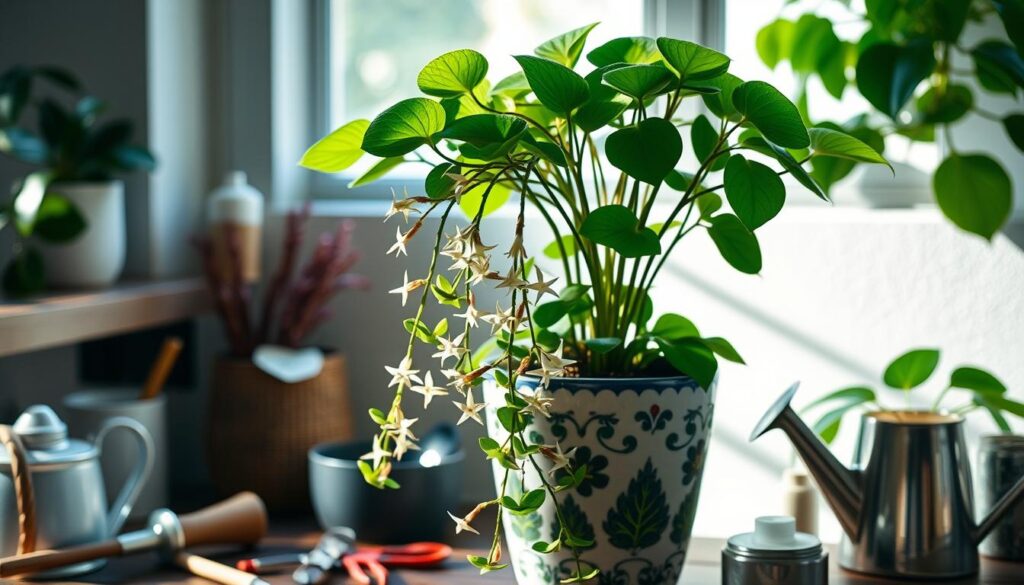
By following Best practices for Hoya care and giving your plant what it needs, you’ll see beautiful flowers. Be careful with water, too much or too little can hurt the buds. With the right care, your Hoya will bloom beautifully and smell great. For more tips, look up Hoya plant care guide and find special advice for your Hoya.
Pest and Disease Management
As a Hoya plant owner, knowing about pests and diseases is key. A good Hoya care guide will teach you how to prevent and treat these problems. Always check your plant for signs of trouble, like sticky honeydew or yellow leaves.
Common pests include mealybugs, aphids, and scale insects. These pests can harm your plant. To prevent them, make sure your pot drains well and keep your plant clean.
Root Rot and Botrytis (Gray Mold) are common diseases. They happen when you water too much. Make sure your pot has holes to drain water and keep your plant healthy.
Preventive Measures
- Regularly inspect your plant for signs of infestation or disease
- Ensure good drainage in pots to prevent waterlogged soil
- Maintain proper lighting and humidity levels
- Quarantine new plants before introducing them to your collection
By taking these steps, you can keep your Hoya plant happy and healthy. Always follow a good Hoya care guide and use the right techniques to solve any problems.
Propagating Hoya Plants
To grow Hoya plants, you need to follow some important steps. First, pick a healthy stem with two nodes. Cut it to 10-15 centimeters long. This helps the stem root well.
For best results, mix Coco Husk and Coco Coir in a 25:75 ratio. Keep the mix moist. But don’t overwater, as it can cause root rot. These steps will help you grow your Hoya plants successfully.
Here are some tips for growing Hoya plants:
- Use rooting hormone to help roots grow, especially in bad weather.
- Don’t disturb the roots much when layering to avoid shock.
- Change the watering if leaves turn yellow or roots show rot signs.
By following these tips and caring for your Hoya plants, you’ll have a good chance of success. You’ll enjoy watching your plants grow and thrive.
With the right care, you can grow your Hoya plants easily. Keep the soil moist but not too wet. Give them the right light and nutrients. This way, you’ll enjoy your Hoya plants for a long time and share them with others.
| Propagation Method | Success Rate | Care Requirements |
|---|---|---|
| Stem Cuttings | High | Consistent moisture, indirect light |
| Layering | Medium | Minimal root disturbance, regular watering |
Environmental Needs for Hoyas
Understanding your Hoya’s needs is key. Think about light, temperature, and humidity. Hoyas love bright, indirect light. A south or west window is great.
But, watch out for direct sunlight. It can make leaves brown and stop growth.
Keep the temperature between 68-75°F for best growth. If it’s too cold, your Hoya might stop growing and not bloom. Hoyas like humidity over 60%. You can use a humidifier or mist them often.
Follow these care tips to make your Hoya happy. Change your care as the seasons change. Water less in winter and more in summer.
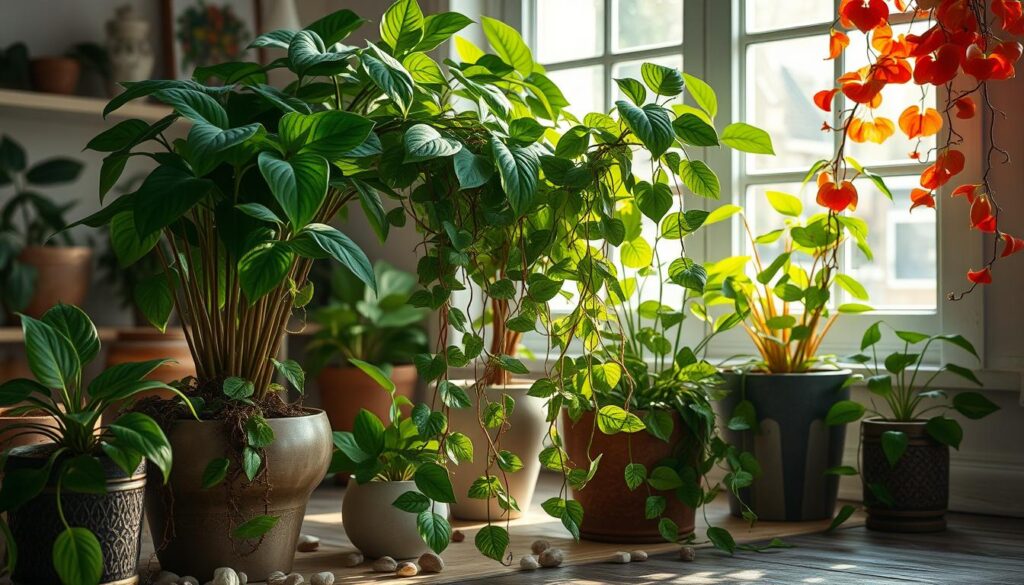
- Maintaining a consistent temperature
- Providing bright, indirect light
- Watering sparingly, allowing soil to dry out between waterings
- Misting regularly to maintain humidity levels
Follow these Hoya care tips to become a Hoya expert. Enjoy the beauty and benefits of these plants.
Troubleshooting Common Issues
When you care for your Hoya plant, you might face some common problems. A good Hoya care guide can help you solve these issues quickly. By using Hoya care techniques and tips, you can fix problems like yellow leaves and leaf drop.
Yellow leaves can happen from too much or too little water, or not enough nutrients. Check the leaves’ texture and color to find the cause. Mushy, yellow leaves mean too much water. Dry, yellow leaves mean not enough water. Yellow leaves starting at the bottom and moving up might mean not enough nutrients.
Yellowing Leaves: What It Means
To fix yellow leaves, change how often you water and feed your plant. Make sure to give it the right amount of water and food. Also, try repotting it in soil that drains well to avoid soggy soil.
Leaf Drop: Causes and Solutions
Leaf drop can be from temperature, humidity, or light changes. To stop leaf drop, keep your plant’s environment steady. You can also increase humidity by putting it on a tray with water and pebbles. By following these tips, your plant will stay healthy and strong.
Fixing common Hoya plant problems takes patience and careful attention. With a good Hoya care guide and techniques, you can quickly find and fix issues. This keeps your plant happy and healthy.
Seasonal Care Tips
When you care for your Hoya plant, think about the seasons. Each season changes how you care for your Hoya. For example, in spring and summer, water and feed it more to help it grow.
In fall and winter, your Hoya needs less water and no food. Watch your plant closely and change your care as needed. This way, your Hoya will stay healthy and happy.
Here are some seasonal care tips for your Hoya:
- Water your Hoya more in spring and summer, and less in fall and winter.
- Fertilize it often when it’s growing, but not when it’s sleeping.
- Keep the air humid, especially in winter, to prevent leaf problems.
Adjusting your care for the seasons helps your Hoya plant grow well. Be ready to change your care as your plant needs. This way, your Hoya will bloom beautifully.
Conclusion: Enjoying Your Hoya Plant
This Hoya care guide has shown you how amazing these plants are. They have beautiful, waxy flowers and don’t need much care. By following our tips, your Hoya plant will do great and make your home happier.
Lasting Benefits of Hoya Care
Good Hoya care makes your home look and feel better. These plants clean the air and make you feel good. They also add a special touch of tropical beauty to any room.
Your Journey with Hoya Plants
This guide has helped you learn how to take care of Hoyas. Whether you’re new or experienced, you now know how to make your Hoyas thrive. Enjoy watching them grow and remember, with the right care, they can make your home beautiful.
If you are really in love with gardening see Michelles YouTube Channel for all things plants.
If you would like to check out other beautiful members of the compact Space category look here at our article of 10 perfect small space houseplants.


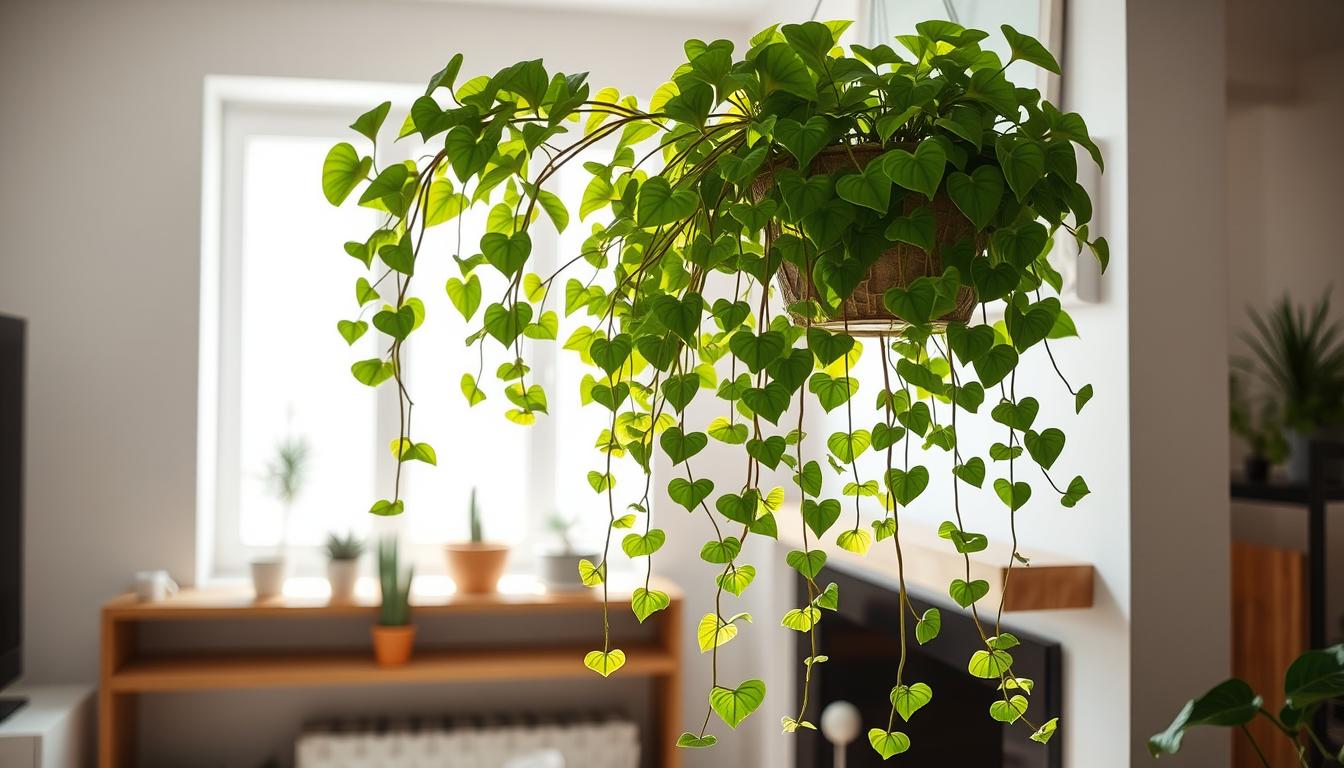
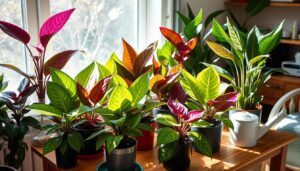
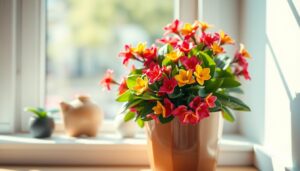
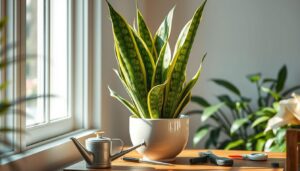
Pingback: The Ultimate Guide to Houseplants: 100 Best Indoor Plants for Every Home - Trusted House Plant Guide